1990 VOLVO 240 warning
[x] Cancel search: warningPage 45 of 143
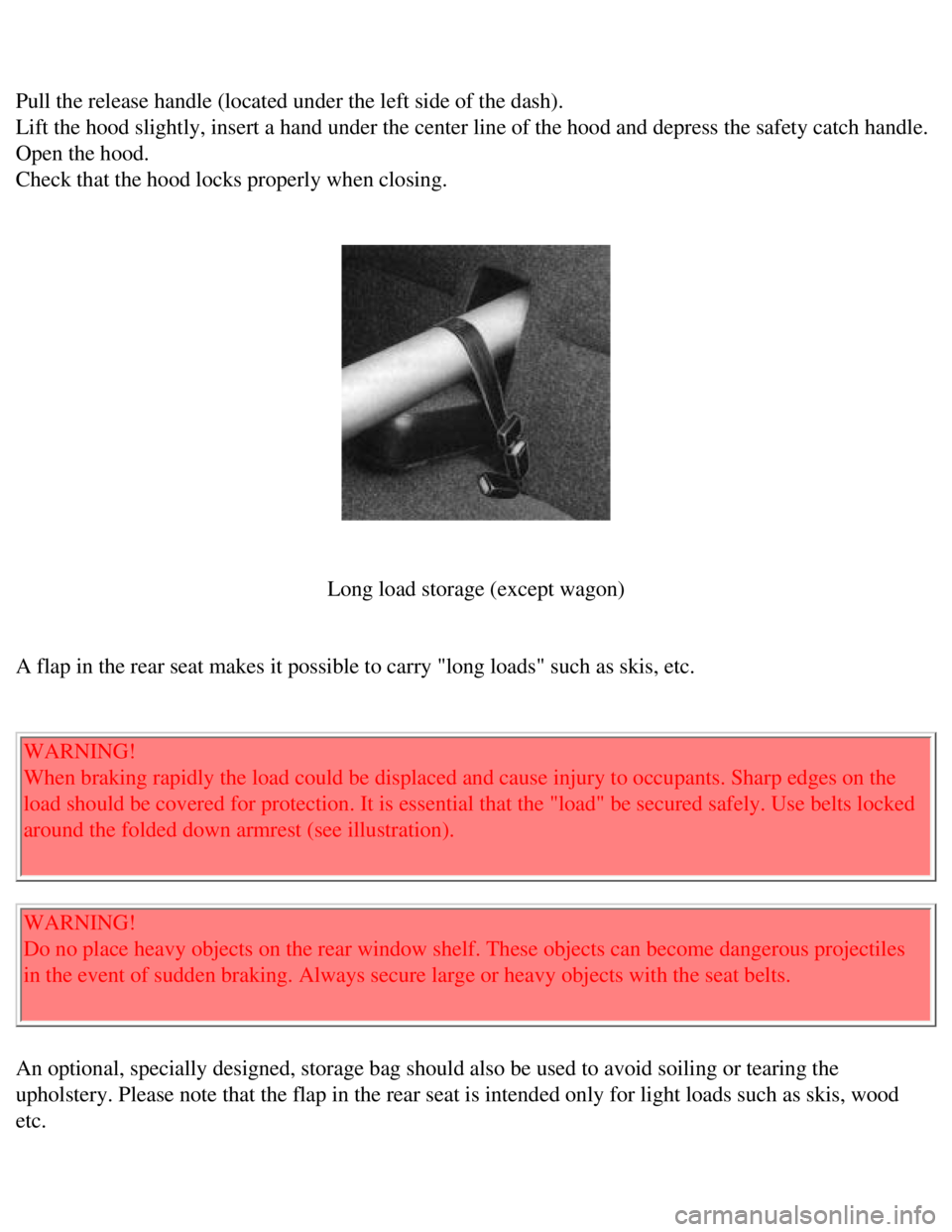
Volvo 1990 240 Model
Pull the release handle (located under the left side of the dash).
Lift the hood slightly, insert a hand under the center line of the hood \
and depress the safety catch handle.
Open the hood.
Check that the hood locks properly when closing.
Long load storage (except wagon)
A flap in the rear seat makes it possible to carry "long loads" such as \
skis, etc.
WARNING!
When braking rapidly the load could be displaced and cause injury to occ\
upants. Sharp edges on the
load should be covered for protection. It is essential that the "load" b\
e secured safely. Use belts locked
around the folded down armrest (see illustration).
WARNING!
Do no place heavy objects on the rear window shelf. These objects can be\
come dangerous projectiles
in the event of sudden braking. Always secure large or heavy objects wit\
h the seat belts.
An optional, specially designed, storage bag should also be used to avoi\
d soiling or tearing the
upholstery. Please note that the flap in the rear seat is intended only \
for light loads such as skis, wood
etc.
file:///K|/ownersdocs/1990/1990_240/90240_07.htm (5 of 6)12/30/2006 8:\
25:04 AM
Page 46 of 143
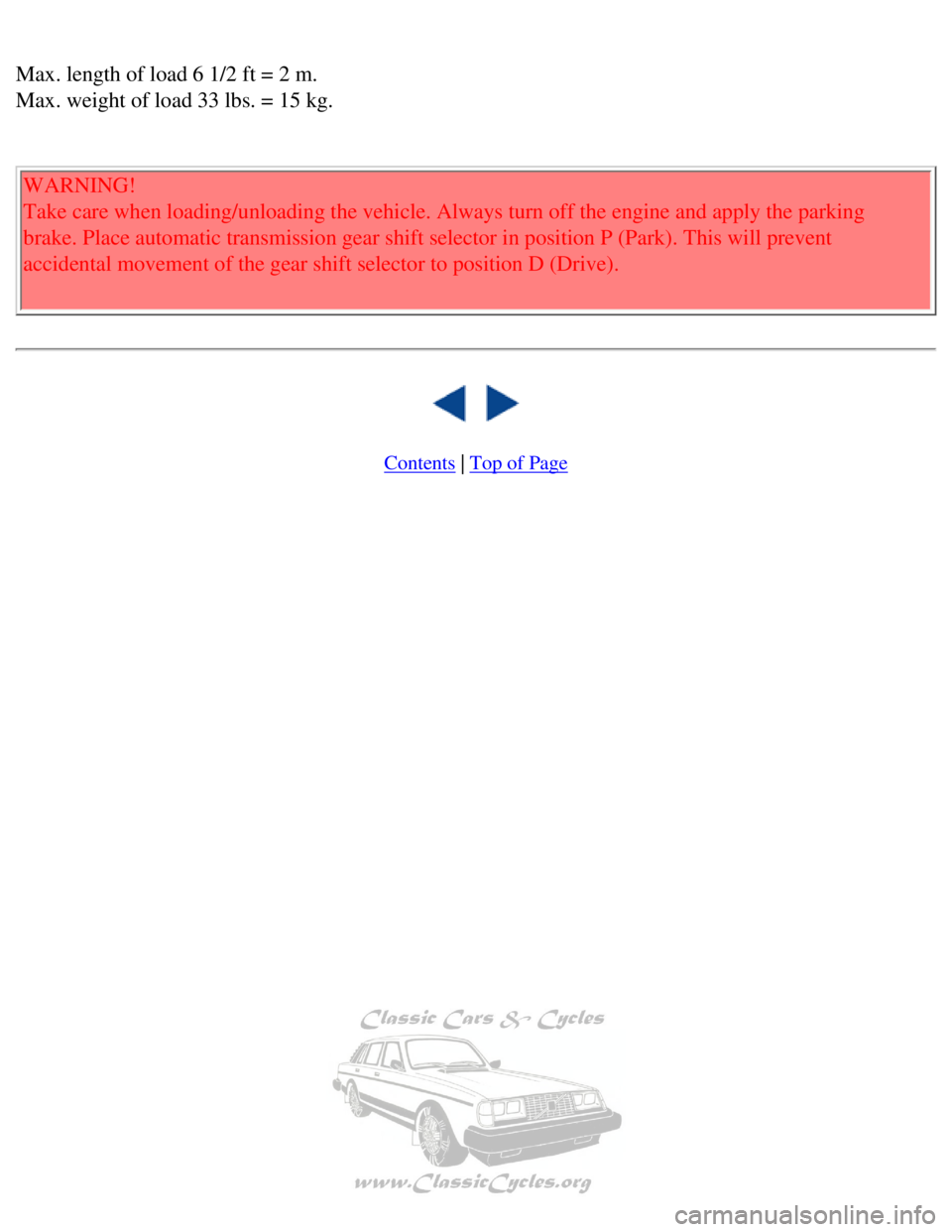
Volvo 1990 240 Model
Max. length of load 6 1/2 ft = 2 m.
Max. weight of load 33 lbs. = 15 kg.
WARNING!
Take care when loading/unloading the vehicle. Always turn off the engine\
and apply the parking
brake. Place automatic transmission gear shift selector in position P (\
Park). This will prevent
accidental movement of the gear shift selector to position D (Drive). \
Contents | Top of Page
file:///K|/ownersdocs/1990/1990_240/90240_07.htm (6 of 6)12/30/2006 8:\
25:04 AM
Page 48 of 143
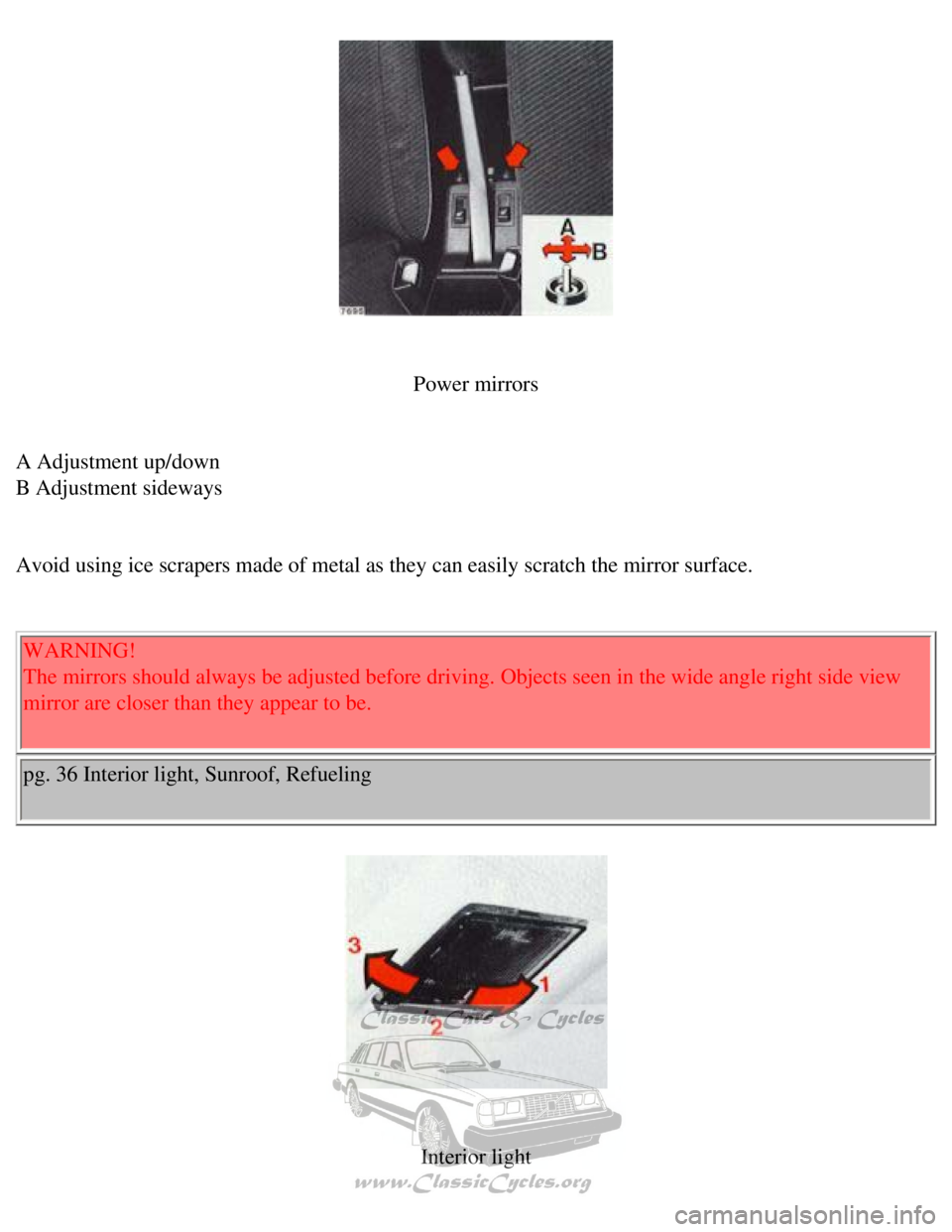
Volvo 1990 240 Model
Power mirrors
A Adjustment up/down
B Adjustment sideways
Avoid using ice scrapers made of metal as they can easily scratch the mi\
rror surface.
WARNING!
The mirrors should always be adjusted before driving. Objects seen in th\
e wide angle right side view
mirror are closer than they appear to be.
pg. 36 Interior light, Sunroof, Refueling
Interior light
file:///K|/ownersdocs/1990/1990_240/90240_08.htm (2 of 4)12/30/2006 8:\
25:04 AM
Page 55 of 143

Volvo 1990 240 Model
Note: Remove foot completely from the clutch pedal after each gear chang\
e when programming the
control unit.
pg. 44 Starting the engine
To start the engine;
1 Enter the car and check that the seat is adjusted properly. Make sure \
that the brake (and clutch) pedal
can be depressed completely. Move the seat closer if necessary.
2 Fasten the seat belt.
3 Apply the parking brake if not already set. Depress the brake pedal wi\
th your right foot.
4 Place the gear selector lever in neutral (position N or P, automatic \
transmission).
5 Depress the clutch pedal (manual transmission).
6 Without touching the accelerator pedal turn the ignition key to starti\
ng position. Release the key as
soon as the engine starts.
Avoid repeated short attempts to start (fuel is injected every time the\
starter is engaged when engine is
cold).
Allow the starter to operate for a longer time (but not more than 15-20\
seconds).
Do not race a cold engine immediately starting.
Engine warm-up-initial driving procedure
Experience shows that engines in vehicles driven short distances are sub\
ject to abnormally rapid wear
because the engine never reaches normal operating temperature.
It is therefore beneficial to reach normal operating temperature as soon\
as possible by driving with a
light foot on the accelerator pedal.
Warning: Always open the garage doors fully before starting the engine i\
nside the garage to ensure
adequate ventilation. The exhaust gases contain carbon monoxide, which i\
s invisible and odorless but
very poisonous.
file:///K|/ownersdocs/1990/1990_240/90240_09.htm (5 of 6)12/30/2006 8:\
25:05 AM
Page 61 of 143

Volvo 1990 240 Model
1. Enter the car and check that the seat is adjusted properly. Make sure\
that the brake pedal can be
depressed completely. Move the seat closer if necessary.
2. Fasten the seat belt.
3. Apply the parking brake if not already set. Depress the brake pedal w\
ith your right foot.
4. Place the gear selector in Park (or neutral).
5. Without touching the accelerator pedal, turn the ignition key to the \
starting position. Release the key
as soon as the engine starts.
6. Select the desired gear. There is a slight delay before the gear enga\
ges which is most notable when
selecting Reverse. Do not accelerate until you have felt the gear engage\
!
Note: Too-rapid acceleration immediately after selecting a gear will cau\
se harsh engagement and
premature transmission wear.
7. Release parking brake, then foot brake, and accelerate. To stop the c\
ar release the accelerator and
apply the brakes with your right foot.
It is not necessary to move the gear selector as the transmission will d\
ownshift automatically.
When idling for extended periods of time, select position N to prevent u\
nnecessary heating of the
transmission.
WARNING! Always place gear selector in Park and apply parking brake befo\
re leaving vehicle. Never
leave car unattended with engine running.
pg. 48 Emergency towing (pulling)
Front eyelet Rear eyelet
file:///K|/ownersdocs/1990/1990_240/90240_10.htm (5 of 7)12/30/2006 8:\
25:05 AM
Page 64 of 143
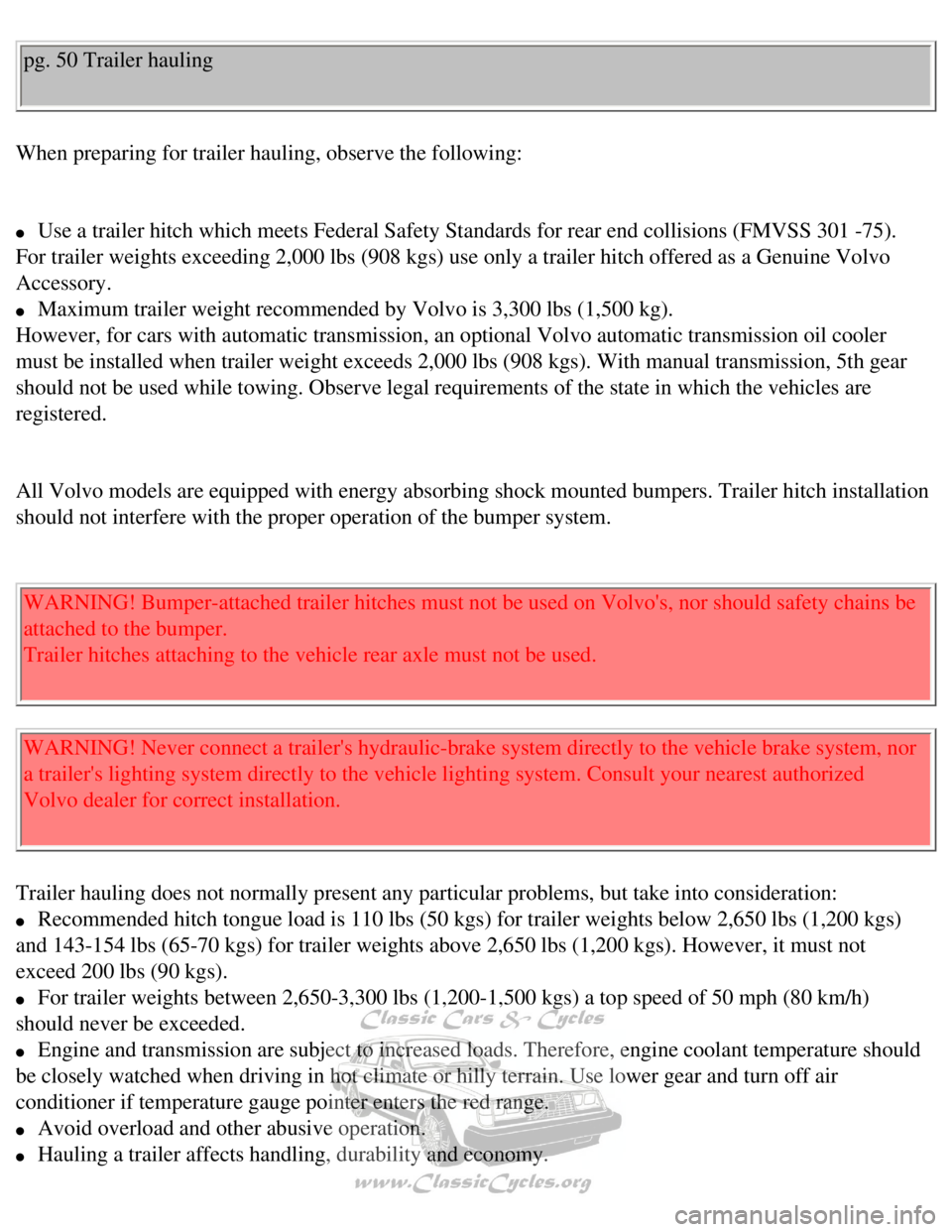
Volvo 1990 240 Model
pg. 50 Trailer hauling
When preparing for trailer hauling, observe the following:
l Use a trailer hitch which meets Federal Safety Standards for rear end co\
llisions (FMVSS 301 -75).
For trailer weights exceeding 2,000 lbs (908 kgs) use only a trailer h\
itch offered as a Genuine Volvo
Accessory.
l Maximum trailer weight recommended by Volvo is 3,300 lbs (1,500 kg). \
However, for cars with automatic transmission, an optional Volvo automat\
ic transmission oil cooler
must be installed when trailer weight exceeds 2,000 lbs (908 kgs). Wit\
h manual transmission, 5th gear
should not be used while towing. Observe legal requirements of the state\
in which the vehicles are
registered.
All Volvo models are equipped with energy absorbing shock mounted bumper\
s. Trailer hitch installation
should not interfere with the proper operation of the bumper system.
WARNING! Bumper-attached trailer hitches must not be used on Volvo's, no\
r should safety chains be
attached to the bumper.
Trailer hitches attaching to the vehicle rear axle must not be used.
WARNING! Never connect a trailer's hydraulic-brake system directly to th\
e vehicle brake system, nor
a trailer's lighting system directly to the vehicle lighting system. Con\
sult your nearest authorized
Volvo dealer for correct installation.
Trailer hauling does not normally present any particular problems, but t\
ake into consideration:
l Recommended hitch tongue load is 110 lbs (50 kgs) for trailer weights \
below 2,650 lbs (1,200 kgs)
and 143-154 lbs (65-70 kgs) for trailer weights above 2,650 lbs (1,20\
0 kgs). However, it must not
exceed 200 lbs (90 kgs).
l For trailer weights between 2,650-3,300 lbs (1,200-1,500 kgs) a top sp\
eed of 50 mph (80 km/h)
should never be exceeded.
l Engine and transmission are subject to increased loads. Therefore, engin\
e coolant temperature should
be closely watched when driving in hot climate or hilly terrain. Use low\
er gear and turn off air
conditioner if temperature gauge pointer enters the red range.
l Avoid overload and other abusive operation.
l Hauling a trailer affects handling, durability and economy.
file:///K|/ownersdocs/1990/1990_240/90240_11.htm (1 of 6)12/30/2006 8:\
25:06 AM
Page 65 of 143
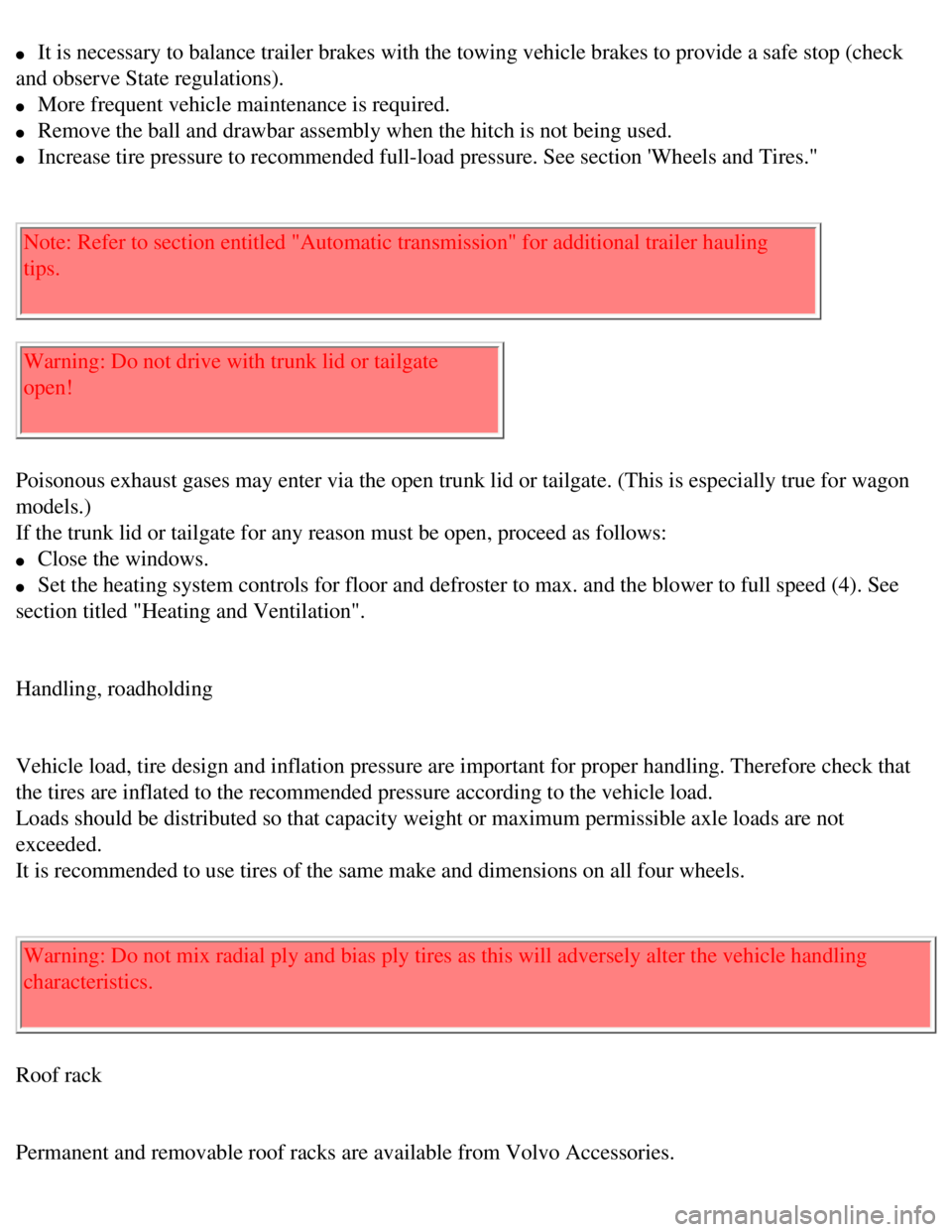
Volvo 1990 240 Model
l It is necessary to balance trailer brakes with the towing vehicle brakes\
to provide a safe stop (check
and observe State regulations).
l More frequent vehicle maintenance is required.
l Remove the ball and drawbar assembly when the hitch is not being used.
l Increase tire pressure to recommended full-load pressure. See section 'W\
heels and Tires."
Note: Refer to section entitled "Automatic transmission" for additional \
trailer hauling
tips.
Warning: Do not drive with trunk lid or tailgate
open!
Poisonous exhaust gases may enter via the open trunk lid or tailgate. (\
This is especially true for wagon
models.)
If the trunk lid or tailgate for any reason must be open, proceed as fol\
lows:
l Close the windows.
l Set the heating system controls for floor and defroster to max. and the \
blower to full speed (4). See
section titled "Heating and Ventilation".
Handling, roadholding
Vehicle load, tire design and inflation pressure are important for prope\
r handling. Therefore check that
the tires are inflated to the recommended pressure according to the vehi\
cle load.
Loads should be distributed so that capacity weight or maximum permissib\
le axle loads are not
exceeded.
It is recommended to use tires of the same make and dimensions on all fo\
ur wheels.
Warning: Do not mix radial ply and bias ply tires as this will adversely\
alter the vehicle handling
characteristics.
Roof rack
Permanent and removable roof racks are available from Volvo Accessories.\
file:///K|/ownersdocs/1990/1990_240/90240_11.htm (2 of 6)12/30/2006 8:\
25:06 AM
Page 67 of 143

Volvo 1990 240 Model
The power assist to the brakes functions only when the engine is running\
. When the car is moving
without the engine running the brake pedal pressure required to stop the\
car is increased 3- 4 times.
The brake pedal feels stiff and hard.
Disc brake noise: A slight-to-moderate amount of disc brake "squeal" is \
considered normal.
Air dam (front spoiler)
A non-factory air dam can negatively influence the normal flow of coolin\
g air to the front wheel brakes.
(See section titled "Wheels and Tires").
If one of the brake circuits should malfunction the red warning light wi\
ll come on
(See section titled "Warning Lights".)
The pedal stroke increases slightly and the pedal feels softer but the p\
edal pressure required does not
increase noticeably.
If the light comes on while driving and the brake pedal can be depressed\
further than normal, it is an
indication that one of the brake circuits is not functioning. Stop immed\
iately, open engine hood and
check brake fluid level.
Reservoir empty: do NOT drive. Tow car to shop for check/repair of brake\
system. Reservoir not empty:
proceed immediately and with caution to a Volvo dealer for an inspection\
of the brake system.
Severe strain on the brake system
The brakes will be subject to severe strain when driving in mountains or\
hilly areas. The speed is usually
low which means that the cooling of the brake is less efficient than whe\
n driving on level roads.
To reduce the strain on the brakes it is advisable not to use the brakes\
excessively.
Instead, shift into a lower gear and let the engine help with the brakin\
g. A good rule is to use the same
gear downhill as would be used ascending the same grade. For vehicles wi\
th automatic transmission use
position 2, or in some cases, 1.
file:///K|/ownersdocs/1990/1990_240/90240_11.htm (4 of 6)12/30/2006 8:\
25:06 AM